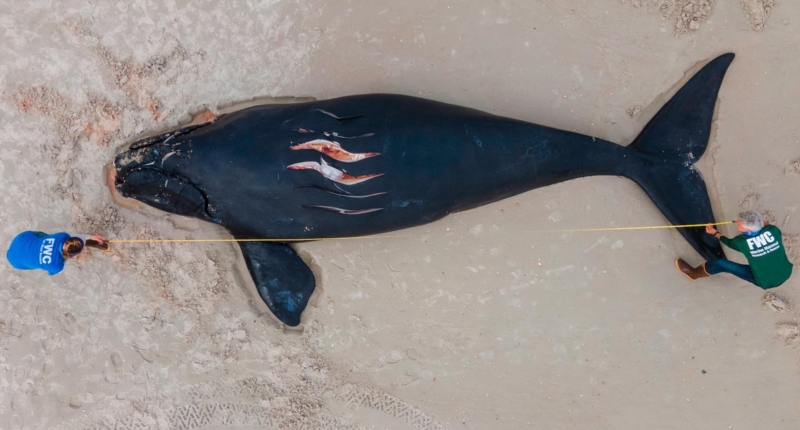The North Atlantic right whale, which is one of the world’s most endangered whale species, is threatened by boat collisions, and a speed limit can protect them. While speed limits have been established, compliance can be low, and critics of the proposed amendment cite safety concerns and economic impacts. Studies have consistently found that speed limits help protect whales, and boat speed is the primary worry. According to Leonard from the American Sportfishing Association, the proposed changes would negatively affect the recreational and sportfishing industry, affecting any boat 35 feet and up. Silber, who helped craft the initial speed rules, supports NOAA Fisheries’ attempts to update the rules, but warned that proposed changes would be difficult to implement and enforce. Greg Reilly, a retired Coast Guard officer, now works for the International Fund for Animal Welfare to try to convince mariners to slow their boats, as slower speeds prevent whale strikes.
Science-Backed Speed Limits to Save Endangered Whales Opposed by Boating Advocates
North Atlantic right whales and boaters face dangers as they navigate the same eastern coastal waters. The fully-grown whales can weigh up to 140,000 pounds and reach over 50 feet, while a midsize, 58-foot-long pleasure yacht can weigh up to 80,000 pounds and cost over $1 million. North Atlantic right whales are especially susceptible to boat strikes, as evidenced by the increasing number of dead whales found off the coast of the United States and Canada since 2017.
To reduce boat-whale collisions, NOAA Fisheries proposed mandatory speed limits of 10 knots in areas where whales are spotted, which includes imposing speed restrictions on recreational and commercial fishing boats. This is the first time recreational boats would be subjected to speed limits, as previously only commercial boats were required to abide by them.
The science behind these proposals is strong, but opposition from industry and fishing groups may stall or prevent the new regulations. Enforcing the new rules may also pose challenges.
A recent incident in Florida highlights the urgency of the issue. In February 2021, a 54-foot sportfishing yacht collided with a North Atlantic right whale mother-calf pair, resulting in the death of the calf and severe injury to the mother. The boat, valued at $1.2 million, was also completely destroyed.
Despite the danger posed to endangered North Atlantic right whales, opposition from industry groups and fishing advocates may stall or prevent the implementation of the proposed speed limits.
Recreational Boating Groups Oppose Proposed Whale Protection Regulations
Efforts to lower speed limits to protect North Atlantic right whales have been slowed by opposition from the recreational boating industry, according to Kathleen Collins, marine campaign manager at the International Fund for Animal Welfare. Several nonprofits filed emergency petitions in December to enact new speed limits as a placeholder until the full rules could be approved. However, the Biden administration rejected the request in mid-January 2023 due to lobbying by industry groups. The Recreational Fishing Alliance (RFA) and the American Sportfishing Association, which represent fishing and boating industry executives, have both opposed the proposed speed rules.
North Atlantic right whales are particularly vulnerable to vessel strikes due to their tendency to swim near the coast and at the water’s surface. The species was hunted to near extinction in the late 1800s and, despite whaling being banned in 1971, the population has not fully recovered.
NOAA Fisheries is set to make a decision on the proposed changes in 2023. Spokesperson Katie Wagner stated in an email that the agency is prioritizing efforts to develop effective, long-term North Atlantic right whale vessel strike reduction measures.
The RFA has encouraged its members to leave public comments opposing the amendments, citing concerns for the freedom of recreational fishers. The group’s board is made up of boating and fishing industry executives, and it was founded by Bill and Bob Healey, who founded the yacht manufacturer Viking Yacht Company. The current RFA chairman is Bob Healey Jr, the current chairman of Viking Group.
Despite the danger to endangered North Atlantic right whales, the recreational boating industry’s pushback has stalled attempts to implement new speed limits to reduce boat-whale collisions. The industry groups’ opposition to the proposed regulations is based primarily on concerns for their members’ livelihoods.
Research Shows High Speeds Increase Risk of Boat-Whale Collisions
Research conducted by Gregory Silber and Richard Pace has found that speed plays a significant role in boat-whale collisions. Their analysis of data from recent whale-ship collisions revealed that the probability of a strike killing or seriously injuring a whale increased dramatically with speed. A risk of 50 percent at 10.5 knots rose to a 90 percent risk at 17 knots. Boats that travel through North Atlantic right whale territory typically travel between 10 and 20 knots.
Silber worked for NOAA Fisheries from 1997 to 2017, and during that time, he studied North Atlantic right whales, focusing on vessel strikes. About 80 to 90 percent of his time was spent on the species, which are most at risk from entanglement in commercial fishing gear and from being struck by boats. Silber believed that setting speed limits was necessary due to the power of the fishing lobby and the complexity of the entanglement issue.
The first paper to suggest that speed may affect boat-whale collisions was published in 2001. The researchers studied 58 documented cases of ships colliding with great whales and found that the most lethal collisions tended to occur when the ship was moving 14 knots or faster. They also found that the whale was not spotted beforehand in most cases. The paper inspired Silber to study the issue further.
Speed limits could help to reduce the number of North Atlantic right whales killed or seriously injured by boats. However, recreational boating groups have opposed the proposed speed limits due to concerns for their members’ livelihoods. Despite these challenges, NOAA Fisheries is prioritizing efforts to develop effective, long-term vessel strike reduction measures for the species.
North Atlantic right whales were hunted to near extinction in the late 1800s, and although they were listed for protection under the Endangered Species Act and the Marine Mammal Protection Act in 1972, their population has not fully recovered. Boat-whale collisions remain a significant threat to the species.
Efforts to Slow Down Vessel Strikes on North Atlantic Right Whales
Off the southeastern coast of the U.S., vessel strikes are the biggest threat to North Atlantic right whales. To address this issue, the International Fund for Animal Welfare and other organizations are educating the maritime community and local governments about right whales to encourage boaters to slow down. In 2008, NOAA Fisheries successfully enacted mandatory speed limits of 10 knots in seasonal management areas and voluntary slow-downs in dynamic management areas where right whales have been spotted.
Compliance Issues
Despite these speed limits, compliance can be low. According to a 2021 report by the nonprofit Oceana, only about 10% of boats stayed within the limit in mandatory zones and 15% did so in voluntary zones from 2017 to 2020. Moreover, these rules apply only to boats that are at least 65 feet long, which are mainly shipping vessels. The compliance issue can be attributed to the complexity of enforcing the speed limits on recreational and commercial fishing boats.
Global Implementation of Speed Limits
The 2008 rule served as a model for other nations like Canada to implement their own rules, and Spain, New Zealand, and Panama have also enacted either mandatory or voluntary speed limits. This move may help preserve the North Atlantic right whales’ population, which has declined significantly due to vessel strikes and entanglement in commercial fishing gear.
Ongoing Efforts to Protect North Atlantic Right Whales
NOAA Fisheries is developing effective, long-term North Atlantic right whale vessel strike reduction measures, and a decision on the proposed changes is forthcoming in 2023. However, industry groups and fishing advocates, as well as potential difficulties with implementation and enforcement, may stall the new rules.
Protecting North Atlantic right whales from vessel strikes is a crucial task, and speed limits have been implemented as a measure to achieve this goal. The mandatory speed limits of 10 knots in seasonal management areas and voluntary slow-downs in dynamic management areas are intended to reduce the risks of fatal collisions. However, low compliance remains an issue, as only around 10% of boats comply with the speed limit in mandatory zones and 15% do so in voluntary zones.
Nevertheless, studies have shown that speed limits do help protect whales. Research has found that strikes at higher speeds are more deadly, and the 2008 speed rule reduced the risk of right whale mortality from ship strikes by 80 to 90 percent. A voluntary speed rule in Canada’s St. Lawrence Estuary resulted in boats going slower, leading to up to a 40% reduction in the risk of lethal strikes with fin whales. Additionally, even though many boats do not follow the speed limit, they may still slow down enough to improve the whale’s chances.
A 2020 study using computer simulations of boats hitting whales indicated that boats of all sizes — not just those bigger than 65 feet — could kill right whales. A 2006 study expanded on the original 2005 analysis, confirming that strikes at faster speeds are more lethal. Similarly, a 2013 study estimated that the 2008 speed rule reduced the risk of right whale mortality from ship strikes by 80 to 90 percent.
To prove that speed kills, Gregory Silber, along with Jonathan Slutsky and Shannon Bettridge, conducted a study in 2010. They put a model whale made of thermoplastic resin in a basin of water and then rammed it with a model container ship at various speeds while an accelerometer recorded the force of impact. The study showed that the hits were worse at faster speeds, but with a ship that large, the forces resulting from a collision could be deadly even at a slow pace.
It is clear that speed limits are an essential measure in protecting North Atlantic right whales from fatal vessel strikes. Further efforts are necessary to ensure compliance with the speed limits to minimize the risks to these endangered animals.
The National Oceanic and Atmospheric Administration (NOAA) has proposed a new amendment to the speed limits in areas where North Atlantic right whales reside. However, critics of the proposed amendment cite safety and economic concerns. Leonard from the American Sportfishing Association believes the new rule will negatively affect the recreational and sportfishing industry, and many members are concerned that it will affect their livelihoods. The new rules would affect any boat 35 feet and up, and the ASA argues that NOAA underestimated the economic impact and number of vessels that the new rules would affect while overestimating the risk of a boat-whale strike. The group commissioned a report by consulting firm Southwick Associates to highlight these concerns.
One of the public comments received by NOAA was from a charter boat operator in North Carolina, stating that the proposed speed limit would double their travel time, and that their customers are paying to fish, not just for an extended boat ride.
NOAA Fisheries claims that they engage with partners, including the fishing and shipping industries, as they develop regulations and management plans, and they pointed to the public comment period. However, Leonard said that there was no collaboration between the ASA and NOAA Fisheries on the new speed rules.
Despite these concerns, studies have consistently shown that speed limits help protect whales. These studies confirm that strikes at faster speeds are deadlier, and that speed limits reduce right whale mortality risk from ship strikes. Even a collision at the 10 knot speed limit could still cause serious harm, according to computer simulations of boats hitting whales.
While economic and safety concerns are legitimate, it is crucial to strike a balance between protecting North Atlantic right whales, whose populations are critically low, and ensuring the continued livelihoods of industries that rely on the waters where these whales live.
Slower Speeds Could Help Protect Endangered Right Whales
In an effort to protect the endangered North Atlantic right whale, the National Oceanic and Atmospheric Administration (NOAA) Fisheries is considering updates to the 2008 speed rules for boats near the southeastern US coast. The rule reduces the risk of ship strikes by 80 to 90 percent, but compliance has been low. A 2021 report by Oceana found that only 10 percent of boats stayed within the speed limit in mandatory zones, and those rules applied only to boats at least 65 feet long. Critics of the proposed amendment argue that it will negatively impact the economy of the recreational and sportfishing industry. However, research shows that slower speeds are the best way to prevent whale strikes.
The 2008 rule serves as a model for other nations, including Canada, Spain, New Zealand, and Panama, which have enacted either mandatory or voluntary speed limits. While Silber, one of the creators of the initial 2008 rule, supports the update, he believes that the changes will be difficult to implement and enforce.
Greg Reilly, who now works for the International Fund for Animal Welfare, said that it is well recognized that nobody wants to harm right whales. Research indicates that slower speeds are the way to prevent whale strikes, and NOAA Fisheries is engaging its partners, including the fishing and shipping industries, as they develop regulations and management plans.
Conclusion
Slowing boats to prevent whale strikes has been proven to be effective, with studies showing an 80 to 90 percent reduction in right whale mortality risk. Despite low compliance with speed limits, many countries have implemented their own rules, including Spain, New Zealand, and Panama. While some criticize the proposed amendment due to its potential impact on the economy, research suggests that slower speeds are the best way to prevent whale strikes.
Don’t miss interesting posts on Famousbio










